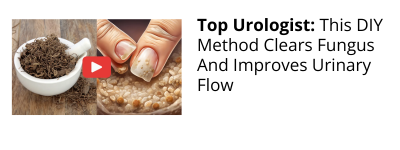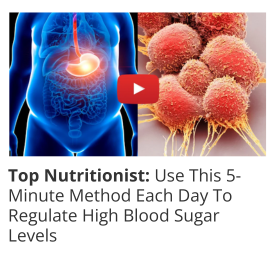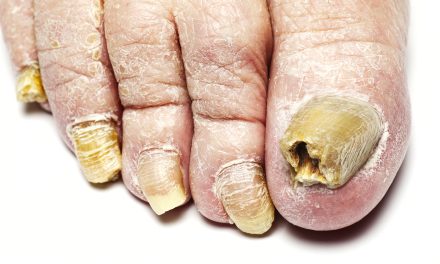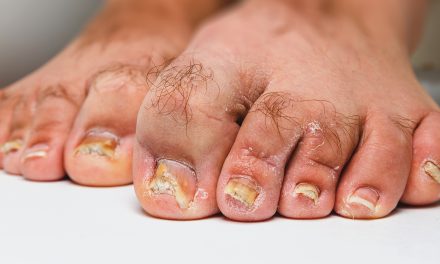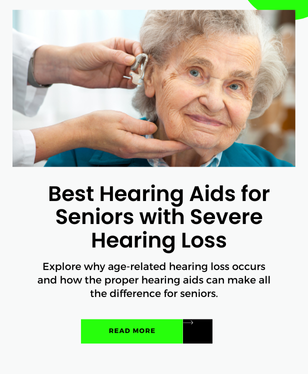Fungal infections on the toes can be both uncomfortable and persistent. They often start as a small yellow or white spot under the tip of the toenail and can cause the nail to thicken, crumble, or discolor.
Proper treatment is essential to prevent the infection from spreading or leading to more serious complications.

Home remedies can be quite helpful for mild infections. These include keeping the foot dry, regularly changing socks, and using over-the-counter antifungal creams.
For more severe cases, medical treatments such as oral antifungal medications or even laser therapy may be necessary. Health professionals can guide patients in choosing the most effective treatment method tailored to the severity and extent of the infection.
Consistently following a treatment plan and maintaining foot hygiene are crucial steps in managing and preventing recurrence.
Wearing breathable shoes, keeping nails trimmed, and avoiding walking barefoot in communal areas can reduce the risk of future infections.
Simple preventive measures and timely treatments can significantly improve foot health.
Key Takeaways
- Toenail fungus requires timely treatment to prevent complications.
- Home remedies and medical treatments vary in effectiveness.
- Good hygiene and preventive measures help avoid recurrence.
Understanding Toenail Fungal Infections
Toenail fungal infections, or onychomycosis, are common and can lead to nail discoloration, thickening, and brittleness. They are more likely in individuals with weakened immune systems or poor circulation, such as those with diabetes.
Identifying Symptoms
Fungal infections often cause toenails to change color, usually to white, yellow, or brown. Affected nails may become thick, brittle, or crumbly, making them difficult to trim. Sometimes, the nail can separate from the nail bed, a condition known as onycholysis. These symptoms can cause discomfort and can be accompanied by a slight odor. If left untreated, the infection may spread to other nails or the surrounding skin.
Common Causes and Risk Factors
Nail fungus thrives in warm, moist environments such as swimming pools, locker rooms, and showers. Walking barefoot in these areas increases the risk of infection.
Individuals with diabetes, poor circulation, or a weakened immune system are at higher risk of developing toenail fungus due to their reduced ability to fight off infections. Wearing tight shoes or using nail polish can also contribute to the development of onychomycosis by trapping moisture.
Proper hygiene and wearing breathable footwear can help prevent these infections.
Diagnosis of Fungal Nail Infections
Fungal nail infections can be tricky to identify. Recognizing when to seek professional help and understanding available diagnostic tests is crucial.
When to See a Healthcare Provider
Signs of a fungal nail infection include thickening, discoloration, and an unusual shape of nails. Early detection ensures effective treatment, so it’s important to seek help if any symptoms appear.
A dermatologist or a podiatrist will often assess the severity of the infection. Persistent infections that don’t respond to over-the-counter treatments or keep coming back require a professional evaluation. Based on the severity, doctors can develop a personalized treatment plan.
Tests for Nail Fungus
To confirm a fungal infection, healthcare providers may use several types of tests. Often, they first visually inspect the nail, then might remove a sample for lab analysis.
Common tests include potassium hydroxide (KOH) preparation, fungal cultures, or nail biopsy.
KOH preparation involves examining a sample under a microscope to detect fungi. A fungal culture cultivates any fungi present to determine the type causing the infection. Nail biopsy is less common but may be used if other tests are inconclusive.
Medical Treatments for Toenail Fungus
Toenail fungus requires medical interventions that primarily involve oral and topical treatments. Each method targets the infection differently, focusing on eliminating the fungus effectively. Understanding the available options helps in choosing the most suitable treatment plan.
Oral Antifungal Medications
Oral medications are often prescribed when topical treatments are not effective. They work internally, attacking the fungus through the bloodstream.
Common choices include itraconazole and terbinafine, which have been shown to be effective against nail fungus. These drugs usually require a prescription and can take several months to show results.
Terbinafine is often a first line due to its high success rate. On the other hand, fluconazole and griseofulvin can also be used, although they might be less commonly recommended. Doctors may monitor liver function during treatment to prevent any adverse effects.
Oral antifungals offer a systemic approach, reaching fungi embedded deep within the nail.
Topical Treatments
Topical treatments involve applying antifungal preparations directly to the affected nail and surrounding skin. These include ciclopirox nail lacquer, efinaconazole solutions, and tavaborole.
Topicals are often more effective for mild to moderate cases and are preferred for patients who cannot take oral medications.
Ciclopirox is a common choice for its wide availability, whereas efinaconazole and tavaborole offer newer options. Efinaconazole and tavaborole may take months of daily application but can penetrate the nail better than older formulations.
Regular use is key to success, making adherence to treatment instructions crucial for achieving clear nails.
Laser and Surgical Options
There are effective methods to treat fungal infections on toes, including laser treatments and surgical options. Laser treatments target the fungus directly, while nail removal methods are sometimes necessary for severe cases.
Laser Treatment Efficacy
Laser treatment is a modern method to address toenail fungal infections. Using focused light beams, it targets the fungal cells beneath the nail.
This method is beneficial when topical creams and other treatments are ineffective. Different lasers, such as the 1064-nm laser and PinPointe™ FootLaser™, have been used with varying success. These procedures are usually painless and have minimal side effects, making them a popular choice.
The success rates for these treatments vary, but they often help improve the appearance of the nail. It’s essential to consult a podiatrist to decide the best treatment approach.
Nail Removal Procedures
In severe fungal infections, where traditional treatments fail, nail removal may be necessary. This procedure involves the surgical removal of the infected nail by a podiatrist.
While it sounds extreme, this is often the last resort for persistent infections. There are two types of nail removal: partial and total.
Partial removal targets only the infected portion, while total removal takes out the entire nail. After removal, antifungal medications are applied to the nail bed to prevent further infection.
Recovery varies but usually involves some discomfort and requires proper foot care to aid healing.
Home Care and Remedies
Treating fungal infections on toes at home often involves natural treatments and lifestyle adjustments to prevent recurrence. Natural products like tea tree oil can be helpful, while regular nail care and choosing the right products also play a vital role in managing the condition.
Topical Natural Treatments
Tea tree oil, known for its antifungal properties, is a popular choice for treating toenail fungus. It can be applied directly to the affected nails once daily. For best results, use a cotton swab for precise application.
Another effective natural remedy is oregano oil, which contains thymol, a compound with antifungal benefits. Oregano oil should be diluted with a carrier oil like olive oil before use to prevent skin irritation.
Some people also use antifungal nail polish that contains specific compounds designed to fight fungal infections.
This type of polish not only treats the fungus but also conceals the discolored nails, which may boost confidence. These polishes are often applied weekly, allowing medication to penetrate and combat the fungus.
Lifestyle and Home Prevention Tips
Keeping feet dry is crucial, as fungi thrive in damp environments. He or she should wear moisture-wicking socks and make sure shoes are dry and breathable. Alternating shoes allows time for drying, thus minimizing the risk of fungal growth.
Regular nail care is important. Trimming nails straight across and smoothing the edges helps prevent trauma, a common entry point for fungal spores. Clean nail tools regularly to avoid contamination.
Avoid walking barefoot in communal areas like locker rooms and pools, where fungi are common. Wearing flip-flops or water shoes can provide a barrier against infections.
Lastly, using foot powders or sprays can help keep feet dry and less susceptible to fungal growth.
Preventing Recurrence and Spread
Preventing the recurrence and spread of fungal infections on toes involves maintaining proper foot hygiene and managing any conditions that may promote fungal growth. Ensuring a clean environment and addressing underlying health issues can significantly reduce the risk of infection return.
Hygienic Practices
Proper foot hygiene is crucial in preventing fungal infections. Regularly washing and thoroughly drying feet, especially between the toes, can prevent moisture buildup, which fungi thrive on.
It’s important to use clean nail clippers and tools, as sharing them can spread infections. Visiting a reputable nail salon that adheres to strict sanitation practices can further protect against contamination.
Wearing breathable shoes and socks can also help keep feet dry. Using antifungal powders can add an extra layer of protection.
People who frequent public spaces like locker rooms should wear shower sandals to minimize exposure to fungi.
Managing Comorbidities
Conditions such as athlete’s foot, jock itch, and psoriasis can create an environment that encourages fungal growth. Managing these comorbidities is essential to preventing further issues with toenail infections.
Keeping skin conditions under control reduces the likelihood of fungi spreading to the nails.
Ensuring overall good health can also assist. Those with diabetes, for example, should be vigilant in foot care, as they are at higher risk for infections. Regular check-ups with healthcare providers can catch and address any underlying issues that may contribute to fungal infections, helping maintain foot health and prevent recurrence.
Complications to Watch For
Fungal infections on toes can lead to numerous problems if not treated properly. Some issues include bacterial infections and associations with other health conditions like diabetes, increasing the risk of foot problems.
When Complications Arise
One significant complication of untreated fungal infections is a bacterial infection, such as cellulitis. Cellulitis is a serious condition that can occur when bacteria enter cracked skin on the foot. This may cause redness, swelling, and can be painful.
Other risks include nail bed ulceration, where ulcers develop under the nails, further weakening the affected area. This can lead to more severe infections and may require medical intervention.
Early signs that complications might be developing include increased pain or redness, especially around the nails. People with weakened immune systems or those with diabetes should pay special attention to changes in their feet.
Associations With Other Conditions
Fungal infections, notably tinea pedis or athlete’s foot, are often linked to other skin conditions. People with conditions like diabetes are at higher risk.
This is because their immune systems are often compromised, making them more vulnerable to infections.
In some cases, the presence of a dermatophyte, which causes fungal infections, can complicate underlying health issues. The fungal infection may worsen existing skin problems, leading to cracks and openings in the skin that bacteria can infect.
Furthermore, those with a history of vascular issues need to be especially cautious. Complications in these individuals might escalate, leading to more complex health problems.
Navigating Treatment Choices
Different methods exist for treating fungal infections on toes. These methods can be discussed with a healthcare provider to determine what suits individual needs best. Consulting a dermatologist and assessing treatment effectiveness are crucial steps in managing these infections.
Consultation With a Specialist
When dealing with fungal infections, seeing a dermatologist or healthcare provider is important. They can identify the type of infection and suggest suitable treatments. The provider may perform tests to confirm the infection first.
An expert’s advice can guide those affected in choosing between topical or oral antifungal medicines. Topical treatments, like creams and gels, work on the surface. Oral medicines help in more severe or stubborn cases but may come with side effects.
Patients should ask about possible interactions with other medications. A specialist can provide personalized advice, considering any underlying health conditions.
Accurate diagnosis and targeted treatment plans offer the best opportunity for a full recovery.
Evaluating Effectiveness of Treatments
The success of antifungal treatments varies.
Topical treatments, including creams and ointments, are often used for mild infections.
They are applied directly to the troubled area to reduce fungus growth.
Oral treatments provide an option for more persistent infections, as they work internally.
Prescription treatments may be necessary if over-the-counter options don’t work.
It’s crucial to follow the treatment for the recommended duration, even if symptoms improve early.
Paying attention to changes in symptoms helps in evaluating treatment success.
Keeping track of recovery progress ensures timely adjustments if needed.
Communicating consistently with the healthcare provider supports effective management and ensures treatments are on track.
Frequently Asked Questions
Finding the right treatment for toenail fungus can be challenging.
There are several effective options ranging from quick remedies to over-the-counter treatments.
Understanding how to identify and manage healing is crucial for effective treatment.
What is the quickest way to get rid of toe fungus?
The quickest treatments often involve prescription oral antifungal medications.
These medications penetrate the nail bed and treat the infection more efficiently than topical treatments.
It’s important for patients to follow their healthcare provider’s instructions carefully to achieve the best results.
What kills toenail fungus most effectively?
Prescription medications are usually the most effective.
Oral antifungal drugs like terbinafine or itraconazole can treat the root cause of the infection.
These treatments are effective because they reach deeper than topical solutions.
A healthcare provider can recommend the best option based on the specific case.
How can severe cases of fungal nail infections be treated?
Severe infections may require more intensive treatment.
This often involves combining oral antifungal medications with topical treatments.
In some cases, laser therapy or nail removal might be necessary for stubborn infections.
Consulting a healthcare professional is essential to determine the right course of action.
What are the best over-the-counter treatments for toenail fungus?
Over-the-counter antifungal creams and ointments can be useful for mild cases.
Products containing clotrimazole or tolnaftate are popular options.
These treatments help stop the growth of the fungus, although they may take longer to show visible results compared to prescription medications.
How can you tell if toenail fungus is healing?
Signs of healing include a clearer and healthier appearance of the nail.
The nail may thicken and lift less from the nail bed.
It’s important to monitor the growth of new, clear nail from the base as a positive indication.
Consistent treatment is critical until the entire nail is free of infection.
Can a fungal infection on your toe be treated at home, and if so, how?
Mild infections may be managed at home with over-the-counter treatments.
Keeping feet dry and clean is vital. Using antifungal sprays or powders can help prevent further infection.
Home remedies like tea tree oil have shown some benefits, though they should be used with caution and as a complement to conventional treatments.






